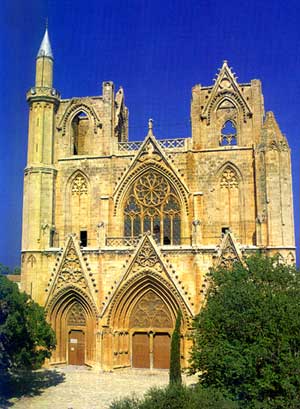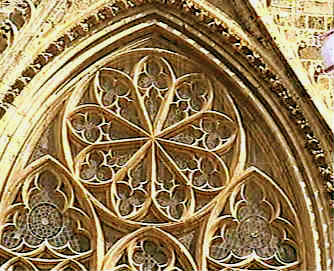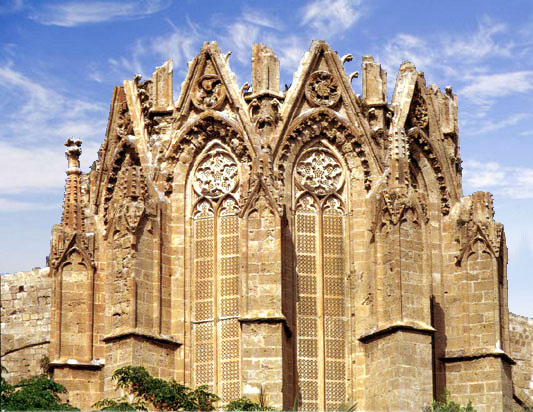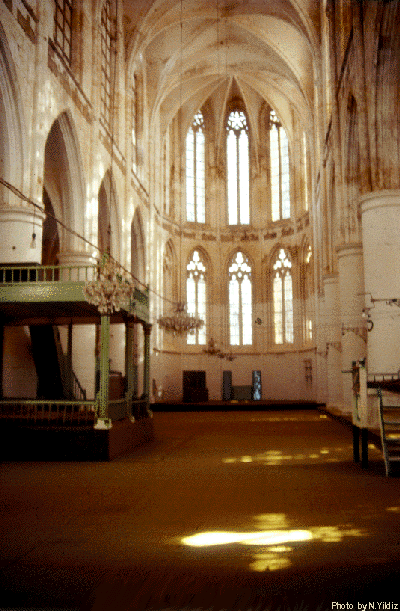
Lala Mustafa
Paşa Mosque (St
Nicholas Cathedral)
 The cathedral of St. Nicholas / Lala Mustafa Pasha Mosque is the largest medieval building
in Famagusta and was commenced in 1300 AD. It must be noted that the great cathedrals of
the Middle Ages often took more than 100 years to complete, so was St. Nicholas was
completed about 1400.
The cathedral of St. Nicholas / Lala Mustafa Pasha Mosque is the largest medieval building
in Famagusta and was commenced in 1300 AD. It must be noted that the great cathedrals of
the Middle Ages often took more than 100 years to complete, so was St. Nicholas was
completed about 1400.
The Gothic style of architecture closely resembles closely the great cathedral of Rheims
in Paris, France.
Similarly, St. Sophia
Cathedral in Nicosia (now Selimiye Mosque) and Bellapais
Abbey all seem to be the work of French architect, and this is understandable when one
realises that the Kings of Cyprus from 1190 to 1489 were all of the French Lusignan
dynasty who, at least in their churches, "Frenchified" Cyprus.
The main facade of the building is the west front and this is shown in the picture.

There
are three large gabled and canopied doorways as can be seen in the picture, the vast
amount of carved stone work being very impressive.
 Above the main central door is a large wheel window set in decorative tracery, a common
feature of French cathedrals and known as a rose window. There is a similar rose window in
the refectory hall at the Bellapais Abbey.
Above the main central door is a large wheel window set in decorative tracery, a common
feature of French cathedrals and known as a rose window. There is a similar rose window in
the refectory hall at the Bellapais Abbey.
The upper parts of the two towers suffered
damage during the Ottoman bombardment of 1571 and when the Ottoman Turks captured the town
from the Venetians, the cathedral was converted into a Mosque and a minaret was added.
The full name of the building today is the Lala Mustafa Pasha Mosque. In accordance with Muslim
religion all images of the human form in stone, fresco, or in stained glass windows were
removed or plastered over. However, all aspects of the Gothic tracery have been preserved.
the canopied doorways of the west front are typical of French cathedrals.

No doubt the
niches on either side of the porch contained stone statues of Biblical saints as in Notre
Dame, Paris. This style of ecclesiastical architecture is known as the "Decorative
Period".
The interior is of course a Muslim prayer hall, the floor being covered with carpets, and
all visitors must go round with the Imam. The main hall in a church is known as the nave,
and here the Lusignans were crowned as kings of Cyprus.
 Tradition claims that they also
received the crown of Jerusalem, as by about 1350 the Crusaders had failed to take
Palestine and so these French knights came to Cyprus to set up a Jerusalem monarchy in
exile!
Tradition claims that they also
received the crown of Jerusalem, as by about 1350 the Crusaders had failed to take
Palestine and so these French knights came to Cyprus to set up a Jerusalem monarchy in
exile!
The lancet windows were probably decorated with stained glass but it was unsafe to have
wide windows as Cyprus suffers from severe earthquakes. Also because of this, the nave had
to be strengthened with flying buttresses.
In 1571, altars and tombs were swept away and
all frescoes were plastered over but the guide will show visitors a few medieval tombs
that have survived, in the north aisle.
 Related Resources
Related Resources
 Photo gallery of the
mosque (cathedral) through time
Photo gallery of the
mosque (cathedral) through time
 The
Cathedral Fig Tree in Famagusta - The oldest living
The
Cathedral Fig Tree in Famagusta - The oldest living
thing in Cyprus
 From: W. Dreghorn, "Famagusta and Salamis Guide Book",
From: W. Dreghorn, "Famagusta and Salamis Guide Book",
K. Rustem & Bro. publishers,
London, 1985.


 The cathedral of St. Nicholas / Lala Mustafa Pasha Mosque is the largest medieval building
in Famagusta and was commenced in 1300 AD. It must be noted that the great cathedrals of
the Middle Ages often took more than 100 years to complete, so was St. Nicholas was
completed about 1400.
The cathedral of St. Nicholas / Lala Mustafa Pasha Mosque is the largest medieval building
in Famagusta and was commenced in 1300 AD. It must be noted that the great cathedrals of
the Middle Ages often took more than 100 years to complete, so was St. Nicholas was
completed about 1400.
 Above the main central door is a large wheel window set in decorative tracery, a common
feature of French cathedrals and known as a rose window. There is a similar rose window in
the refectory hall at the
Above the main central door is a large wheel window set in decorative tracery, a common
feature of French cathedrals and known as a rose window. There is a similar rose window in
the refectory hall at the 
 Tradition claims that they also
received the crown of Jerusalem, as by about 1350 the Crusaders had failed to take
Palestine and so these French knights came to Cyprus to set up a Jerusalem monarchy in
exile!
Tradition claims that they also
received the crown of Jerusalem, as by about 1350 the Crusaders had failed to take
Palestine and so these French knights came to Cyprus to set up a Jerusalem monarchy in
exile!